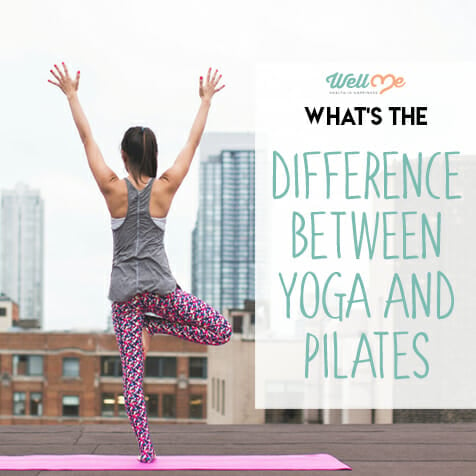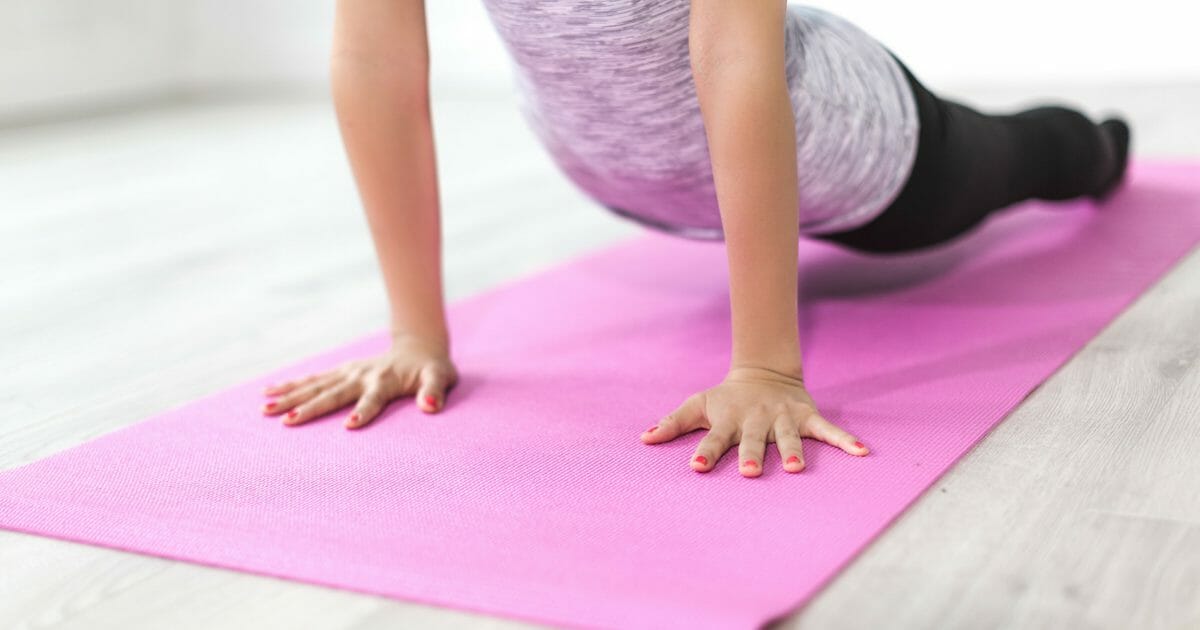Difference Between Yoga and Pilates!
If you’re expecting to improve your physical fitness levels without breaking too much of a sweat, Pilates and yoga are obvious choices. The 2 kinds of activity certainly have a great deal in common; they are both low-impact, have an emphasis on positions and breathing, and extend a slow-paced workout fashion. But is there a difference between Pilates and yoga?
When trying to select which kind of routine is right for you, it is crucial that you get all of the facts. Both of these actions are guaranteed to help you improve your overall wellness but which you choose is dependent upon the specific results you’re looking for. Here is everything you will need to know about the difference between yoga and Pilates.
What is the Difference Between Yoga and Pilates?
Contrary to popular belief, these two practices are not one and the same. While both types offer a low-impact activity, there is a huge difference between Pilates and yoga. When you’re trying to work out which one is ideal for you and your exercise level, you need to know what each involves. Bearing that in mind, let’s take a glance at both Pilates and yoga for women to find out what you could expect from each.
Introduction to Basic Yoga for Women
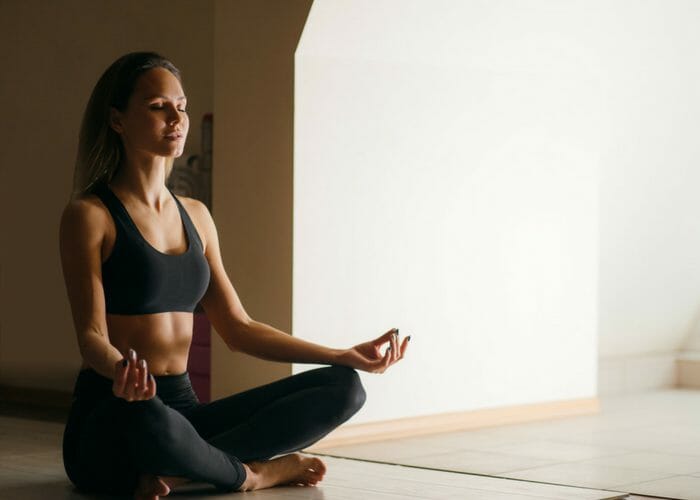
You could be forgiven for thinking that yoga is a relatively new practice, but nothing could be further from the truth. In actuality, this type of exercise has been around for over 5,000 years. The first forms of yoga started in India and since then, people around the world have adopted and adapted the practice.[1]
These days, you can find yoga classes all around the world in leisure centers, gyms, schools, and even as a form of therapy.[2] Basic yoga involves a series of poses or movements along with breathing practices. The entire routine comes together in what many yogis (i.e. yoga enthusiasts) call a flow.
So, what’s the main difference between yoga and pilates? Well, when you try the former, yoga uses the weight of your own body as a form of resistance. Although it may appear quite slow and easy, you should find that basic yoga offers a full workout. The focus is on improving the flexibility of joints and muscles, which you achieve through a series of stretches and poses. But that’s not all. The practice also has a spiritual side to it.
Meditation, relaxation, and spiritual awakening all come together in the practice of yoga for women. Connecting the mind, body, and spirit is a huge aspect of the activity. However, how this aim is achieved differs greatly depending on which class you attend.
There are now many different types of yoga and different trainers have customized the practice. If you’re hoping to try yoga at home, you might want to take a moment to learn about the different types. Here are a few key forms:
Hatha Yoga
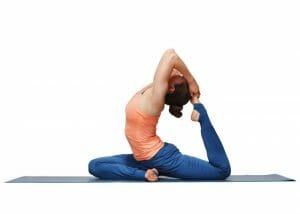
Meaning “force,” the word Hatha describes a form of yoga that has become highly popular in recent years. The focus is on movements and physical activity. There is also an element of spirituality here too. This type of practice is an excellent form of yoga for women as it’s medium impact and easy to learn.
Hot Yoga
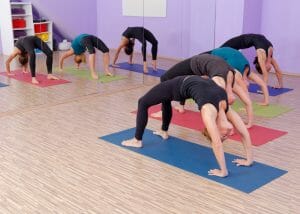
Ready to get your sweat on? When you’re looking at the different types of yoga, this one is certain to stand out. Hot yoga takes place in a warm, humid space, much like a sauna. The idea is that the heat allows people to push deeper into their poses and get more out of them. Be careful when practicing this activity and make sure you hydrate.
Vinyasa Yoga
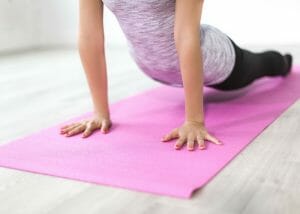
Many of the types of yoga for women are slow in pace. That’s where Vinyasa yoga is different. This yoga workout follows a predetermined sequence of poses which you will need to follow quickly. Think of it a little like a dance class where you have to learn and follow a specific routine. It gives you a cardio blast and a deep stretch.
Of course, there are many more different types of yoga out there and this is just a short introduction to what you can expect. One difference between yoga and pilates is the fact that there are so many branches of yoga. On the other hand, pilates workout classes tend to follow the same basic structure as one another.
Intro to Pilates for Beginners
Pilates is the name for exercises which focus on balance, strength, posture, and flexibility. One of the most exciting advantages of pilates exercises for beginners is that they are suitable for women of all ages and abilities.[3] Perhaps the main difference between yoga and pilates is the fact that the latter doesn’t only take place on a mat.
Much like yoga, pilates uses your body’s own weight as a form of resistance. However, a major difference between yoga and pilates is the fact that there is the use of machines as well as some mat work. The main underlying aim is to release tension in your muscles and strengthen them through a series of poses. However, different forms such as pilates for weight loss may have a cardio element to them to get your heart pumping.
When you enter a Pilates class, you could find that you end up using machines and other equipment to supplement your mat work. This aspect of the Pilates workout takes the exercise to a new level and truly sets it apart from yoga. Here is a quick list of the equipment you may use during an average Pilates workout:
The Reformer
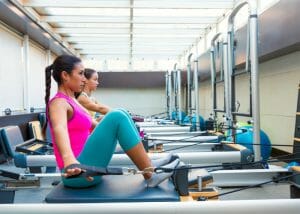
A reformer machine is a cross-training tool which helps to increase your levels of resistance. The machine has a series of springs, ropes and pulleys. To use it, you pull and push on various areas of the equipment to get the greatest pilates benefits. While it may look daunting, the machine can be easy to use.
Cadillac
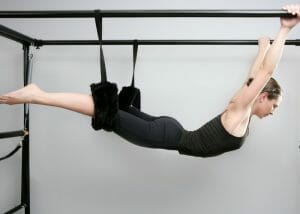
The cadillac is a trapeze table which you can use in some types of Pilates workout classes. It usually has leg and arm springs, roll-down bars, a trapeze, and a push-through bar. It’s not likely that this equipment would be preferable for Pilates for beginners. It is quite an advanced piece of gear but could work when trying Pilates for weight loss reasons.
Wunda Chair
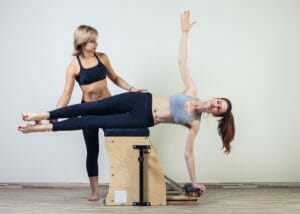
This piece of resistance equipment looks much like a box and has pedals, springs, and a part which you can push down. Some Pilates workout classes rely exclusively on this gear. Of course, if you’re going to use the Wunda Chair (or any of the other pieces of equipment we’ve listed here) you need to make sure that you have proper guidance.
Whether you use this Pilates gear or not, one of the most impressive Pilates benefits is the fact that the routine works your entire body all at once. A telltale difference between yoga and Pilates is that the latter may include a fast-paced bout of exercise and resistance. This means that those trying Pilates for weight loss are almost certain to gain some serious results. While the Pilates workout classes may not be the most intense, they do offer a full conditioning activity which should help you to tone up.
What Are the Benefits of Yoga for Women?
There’s a lot of hype when it comes to yoga for women, but what’s the truth of the matter? There is more than one difference between yoga and Pilates in terms of their benefits. If you’re considering starting basic yoga, you might want to know what the benefits of this practice are and why you should bother. Let’s explore some of the main science-backed benefits of yoga for women.
1. Combats Depression
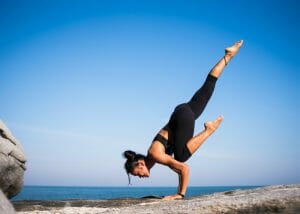
Depression is no light matter. It’s one of the most common mental illnesses in the world and many women experience at one time or another. Statistics show that 12 million women suffer from clinical depression in America and one in eight women will develop the disorder at some point in their life. The condition is most common among women between the ages of 25 and 44.[4]
Categorized by low moods, fatigue, low self-esteem, anxiety, and in extreme circumstances, suicidal thoughts, this illness can be tough to manage.[5] Since women experience depression at around twice the rate that men do, it’s crucial that we take action and try to prevent the problem from occurring.[6]
Surprisingly, one of the major benefits of yoga for women is that it can dramatically decrease the symptoms of depression. One study from the American Psychological Association (APA) found that twice-weekly yoga classes could help sufferers lower the signs of their depression.[7]
2. Helps Women with Breast Cancer
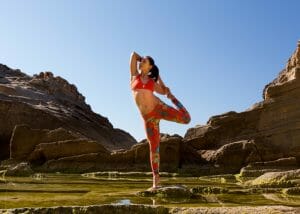
While both men and women can develop breast cancer, this disease is most common in women. Around one in eight women will develop breast cancer at some point during their life.[8] While cases of this form of cancer have started to decrease since the year 2000, it is still one of the most worrying illnesses of our time.
One of the ways in which this disease affects women is that it impacts their quality of life. Once a woman gets a cancer diagnosis, she may have to begin radiation therapy which could drain her energy levels. We already know that mindfulness can improve your quality of life, so how can yoga have an impact?
One study from the University of Texas suggests that there are many benefits of yoga for women who are suffering from breast cancer. The research found that the participants who took part in yoga for women had lower levels of fatigue and a higher quality of life compared to the control group.[9]
There is currently no evidence that pilates has the same effect. That is a difference between yoga and pilates that may set them apart. The takeaway is that trying yoga at home or in a class environment could be a real support to breast cancer sufferers.
3. Battles Chronic Pain
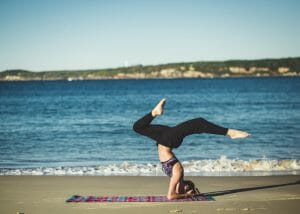
Battling chronic back pain on a day-to-day basis can be hard to deal with. Of course, you can take medication to help deal with the pain, but often enough, this can cause sufferers to deal with some nasty side effects. If you’re looking for a holistic approach, you could find that yoga is the answer.
One of the major causes of back pain is a little-known illness. Fibromyalgia is a medical condition in which sufferers have high levels of chronic pain. The disorder affects 10 million people in the US alone. What’s more, around 75-90% of suffers are women. People usually get this diagnosis between the age of 20 and 50.[10] While it’s not one of the most well-reported conditions, it’s a traumatic illness for those who live with it on a day-to-day basis.
While there are many forms of treatment for fibromyalgia out there, one of the less intrusive forms of therapy could be a simple yoga workout. Research from the Oregon Health & Science University found that basic yoga could help people combat the signs of this illness which include chronic pain, sleeplessness, and headaches.[11] Experts suggest that yoga could be one way to help women who are struggling with the illness.
In theory, practicing yoga on a regular basis could mean that those who suffer from back pain get some form of relief. There’s no denying the fact that one of the benefits of yoga for women is that it helps relax muscles and relieve pain. If you’re suffering with an ongoing condition, giving it a whirl could be the way to go.
4. Helps to Deal with Anxiety

Once a taboo subject, these days people are opening up more and more about mental illness. Aside from depression, there is another condition which is widespread across the US and the world. Around 6.8 million adults suffer from generalized anxiety disorder in America and women are twice as likely to be affected than men.[12]
In many cases, someone who suffers from depression will also have anxiety. The two are not mutually exclusive and can often manifest in the same person. Finding ways to deal with these problems can be tricky and, often enough, we should look toward alternative forms of therapy to support sufferers.
While you may not realize it, one of the greatest benefits of yoga for women could be a boost in mood and a reduction of anxiety. One study from the Boston University Medical Center found that this form of exercise had a greater effect than other activities. The results suggest that basic yoga could improve people’s overall mood and lower their symptoms of anxiety.[13]
Many people rely on yoga when it comes to stress relief and coping with anxiety. On the other hand, pilates has less of a focus on your mental wellbeing. The difference between yoga and pilates is that one is about exercise whereas the other tackles a range of wellness issues.
5. Lowers Stress in Expectant Mothers
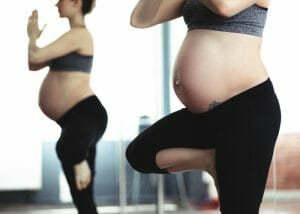
When you’re expecting a child, it can be a little overwhelming. Many women find that they experience high levels of stress during their pregnancy. Tackling this problem is of the utmost importance. Pregnancy stress could result in premature birth, developmental problems, or a low birth weight .[14] For that reason, women must do all that they can to relieve the stress before things get out of hand.
Researchers from Manchester University worked with pregnant women for a period of eight weeks. Over the course of the trial, some of the expectant mothers took part in weekly yoga routine classes while others did not.
The results found that a single yoga workout reduced anxiety levels by a third and cut stress hormones by a massive 14%.[15] These results suggest that the benefits of yoga for women who are pregnant could be higher than many of us previously believed.
The Top 5 Pilates Benefits for Women
Now that we’ve covered the benefits of yoga for women, let’s take a look at what Pilates has to offer. Since there is a difference between yoga and Pilates, you can expect to get different results when you start this exercise. Luckily, the Pilates benefits are great and you could find that giving this activity a go offers some real advantages.
1. Pain Reduction During Pregnancy
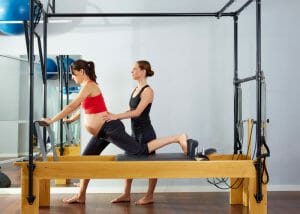
It’s quite normal to experience some level of pain during pregnancy. When you’re about to have a child, you might find that you start to get aches and pains. Alongside these problems, many women also experience low mood which can be an issue. Needless to say, it’s essential to tackle these problems head-on.
Experts believe that all forms of exercise could be beneficial to expectant mothers. Researchers note that pilates, which is often recommended by doctors during pregnancy, could help to improve mental health and reduce pain levels.[16] Trying some pilates at home or joining a class at a local gym could be a smart move when carrying a child.
2. Reduces the Risk of Injury
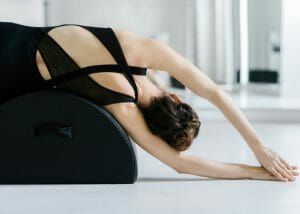
Are you an active woman? If you already engage in frequent physical exercise such as dancing, running, or even weight training, you might find that taking up Pilates is the way to go. All of the above could increase your chances of injuring yourself during an exercise session. That is something that you want to avoid at all costs.
Practitioners and experts in the field suggest that athletes and dancers should reap some of the most common Pilates benefits.[17] Since this practice helps to boost strength levels and improve flexibility, the theory is that people who undertake it could be at a lower risk of injury. Starting some Pilates exercises for beginners could be a simple way to improve your fitness game when it comes to other sports or dancing.
3. Tackles Back Pain
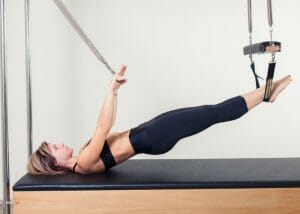
You may be under the impression that back pain is no big deal. However, this ailment is sweeping the nation and could affect more people than you imagine. Statistics from the American Chiropractic Association show that around half of working people in the country experience back pain each year.[18]
Around 80% of the greater population will experience this health concern at some point in their lives.[19] Women could experience this condition to a greater level as those with large breasts may find that the excess weight is to blame for the pain.
Tackling the problem of chronic back pain is anything but cheap. Americans spend around $50 billion on therapy and medicine for back pain each year.[20] Unless you want to fork out a load of cash, you might want to find a cheap alternative to traditional treatment. A remarkable difference between yoga and Pilates is that the latter can help to lower back pain levels.
The UK National Health Service recommends some forms of pilates to help people with non-specific back pain. The experts note that the use of equipment could help to support sufferers when executing exercises. However, the experts also explain that the routines should be tailored to a person’s needs if they are to be effective in relieving pain.[21]
4. Improves Posture
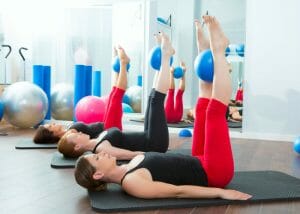
Do you have good posture? Some of the most common mistakes people make when it comes to their posture include slouching in chairs, standing with a flat back, and leaning on one leg.[22] If you are guilty of any of these issues, you could find that it leads to muscle tension in the long run, which may be somewhat painful.
Embarking on a routine of pilates exercises for beginners could help you solve some of these problems. Research suggests that lumbar extension improves immediately after a pilates workout in older people.[23] The result suggests that trying this routine could improve your seated posture. This lesser-known pilates benefit for women is worth keeping in mind.
5. Maintain a Healthy Weight
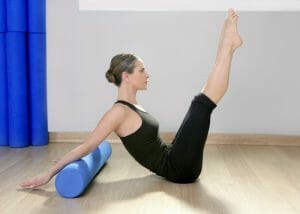
Obesity is one of the leading problems in America. Around 66% of US women are obese while more than 25% are overweight, according to National Center for Health Statistics (NCHS) data.[24] If left untreated, this condition can lead to type 2 diabetes, coronary heart disease, a risk of stroke, and higher risks of some forms of cancer.[25] It could also lead to depression and other mental health issues.[26]
Maintaining a healthy weight can be difficult, especially if you already have some unhealthy lifestyle habits. Overeating is, of course, one of the major causes of obesity but a lack of activity is also to blame. Many have started practicing pilates for weight loss reasons and there’s evidence to suggest that this could be a healthful move.
Information from the UK National Health Service suggests that this muscle-strengthening activity could help people maintain a healthy weight.[27] The advice is that, if you’re hoping to shed some pounds, you should mix pilates, some form of aerobic activity, and a balanced diet. Aerobic activities could include cycling, running, or swimming.[28]
What Are the Best Pilates Exercises for Beginners?
Do you fancy trying a Pilates workout for yourself? You don’t have to pay for an expensive class to get started. In fact, you can try Pilates at home all by yourself. As we have already mentioned, a difference between yoga and Pilates is that Pilates uses equipment. However, you can try some of the basic exercises without it. All you need is a mat, exercise clothes, and a little information. Without further ado, here are some of the best Pilates exercises for beginners.
The Ball Roll
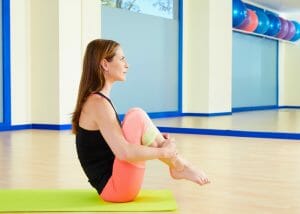
Sit up on a mat and bring your knees toward your chest so that your spine is curved. When you’ve perfected this ball-like position, gently roll backward as far as you can and then forward again. It may sound like a silly Pilates workout but it helps to massage your back.
Pelvic Curve
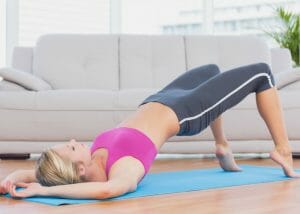
Perhaps one of the most famous Pilates exercises for beginners is the pelvic curve. To do this activity, you should start on your back with your knees bent and your feet on the floor. Lay your arms down either side of your body. Slowly lift your pelvis and stomach while keeping the rest of your body in the same position. Repeat this movement while breathing deeply and focusing on your breath.
Leg Circles
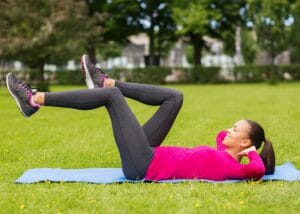
As the name suggests, the main element of this next exercise is making small, precise circles with your leg. Lay on your back with your arms each side of you, your knees raised, and your feet flat on the floor. Stretch out one leg and lift it as high as feels comfortable. Slowly move your leg in a circular motion for a few repetitions.
These Pilates exercises for beginners make an excellent starting point when you first begin practicing the activity. Of course, there are loads of simple Pilates workout moves you can try for yourself. Spend some time researching the difference between yoga and Pilates and consider heading to a class near you when you’re ready to take things to the next level.
Tips for Getting Started with Basic Yoga
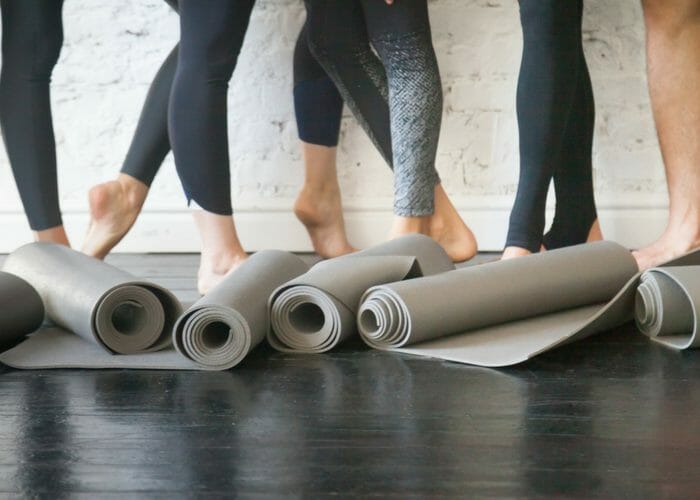
If you’ve researched and understood the difference between yoga and Pilates and chosen to start basic yoga, you need a few tips. This practice is easy to adopt. Since it’s extremely popular, you should have no problem finding all of the information that you need. Here are some tips on getting started with yoga for women.
Get some yoga gear
Before you can call yourself a true yogi, you need to make sure that you have the right gear. Most people agree that comfortable, loose-fitting clothes are the best type for this practice. You may also want to invest in a mat so you can try yoga at home as well.
Watch YouTube tutorials
If you’re not quite ready to head to a class, you could try some yoga at home with a little help from YouTube. There are loads of fitness channels on the platform and many are dedicated to yoga specifically. Search for “yoga for women” and see what you find.
Find a local class
One of the things many women love about yoga is the sense of community it gives them. You can only get this from a class environment. With that in mind, it could be worth searching for yoga for women lessons near you. Gyms and community centers often offer basic yoga sessions so do your research.
Research, research, research
As we’ve already discussed, there are many different types of yoga out there. You should be aware that each class will be unique. Not all sessions will be suitable for beginners. When you’re looking online, make sure that you search for basic yoga rather than any other form. If you’re unsure about a certain class, inquire before attending.
Try Some Basic Yoga Exercises
Now that you’ve got some tips to help you start, you might want to learn some of the basic yoga moves. A difference between yoga and Pilates is that you don’t need gear for yoga. There are loads of poses to master and you need a proper instructor to help you get them right. To get you started, here are just three ways to try yoga at home.
Learn to Breathe
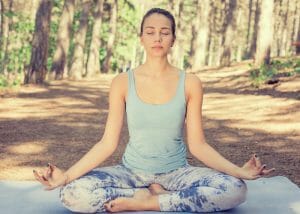
One of the most important elements of basic yoga is your breath. You will need to take full control of your breathing to make sure that you can gain the best benefits of yoga for women. Pranayama, the basic yoga breathing practice, is a three-part system. The idea is that you fill your lungs as much as you can, exhale deeply, and then reverse the flow. At first, you might find that it’s hard to get your head around but give it time.
Cat to Cow Pose
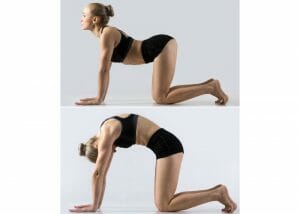
Start on your hands and knees in the “cat” position. Ensure that your back is as straight as possible and clench your abs. Gently arch your back upward so that it curves into the “cow” position. As you move, make sure that you take a deep breath in and out. Repeat this action several times. You may have to adjust your movement and correct your position as you go. In time, you should find that this pose is easy to do.
Downward Facing Dog Pose
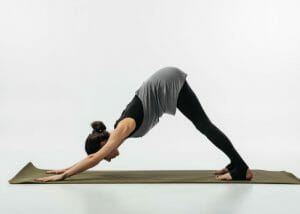
For this pose, you start in the same position you did for the Cat to Cow pose. You should inhale deeply. Move the lower half of your body upward and push backward while stretching out your arms. Spread out your fingers and really sink deep into the position. Your body should slope upward toward its lower half while your arms and upper body is near the floor. It’s easier than it sounds. Mastering this basic yoga pose should be your first step.
How to Choose Between Pilates vs Yoga
So, which should you choose? When it comes down to Pilates vs yoga, the decision is up to you. Both of these practices offer benefits for women but they are quite different in their own way. For instance, while yoga takes a spiritual angle when it comes to exercise, the practice of Pilates does not. That is a difference between Pilates and yoga worth considering.
The way in which you practice each activity differs too. In your standard yoga class, the majority of exercises are mat work, i.e. they take place on a mat. You move from pose to pose in a predetermined sequence. Some forms have sequences that never change while others (the modernized styles) have flexible routines.
On the other hand, Pilates uses both mat work and exercise machines to get the job done. Much like any other exercise class, you could find that the trainer determines the routine you undertake. While there is a focus on breathing, it’s unlikely that you will find any meditation or spiritual element in a Pilates session.
As we have covered throughout this article, there is not just one difference between yoga and Pilates. That means that choosing one is a case of figuring out what you truly want from your workout and how you hope to get it. Here are some pointers to help you decide.
Similarities: Yoga vs Pilates
- Low-impact
- Focus on breathing exercises
- Generally slow-paced activities
- Promotes flexibility
- Can be done at home
- Tones abs and muscles
- Can relieve pain, including back pain
Reasons to Choose Pilates
- Builds core strength
- Varied exercises using mats and machines
- Could include cardio element
- The option of an intense workout
Reasons to Choose Yoga
- Reduce stress levels
- Connect the mind, body, and soul
- No need for extra equipment
- Various forms of yoga
As you can see, while some of the reasons are similar from discipline to discipline, there is more than one difference between yoga and Pilates. Figuring out what works for you is means weighing up the possible advantages and the difference between yoga and Pilates. It could also help to try each of the activities out and see which you find easiest and most approachable. Give them a go today!
